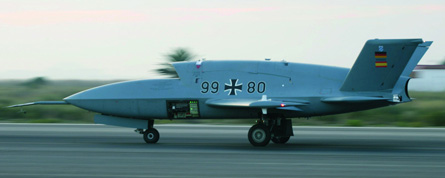EADS says it will make a final decision on whether to build a second Barracuda unmanned air vehicle demonstrator by the end of this year, with discussions under way with the German defence ministry on requirements for construction of a second aircraft to support its Agile UAV in a network-centric environment programme.
The first Barracuda demonstrator had been planned for use as a major trials asset in the Agile programme, but was lost on its second test flight in September 2006 because of software errors.
 |
|---|
© EADS |
The proposed Barracuda II would be identical to the first demonstrator, says Dr Peter Becher, vice-president autonomous airborne systems for EADS Defence & Security. "We will rebuild. It will be the same configuration as the Barracuda I," he says.
EADS self-funded manufacture of the first Barracuda, but received considerable assistance in kind from the German defence ministry. Becher says current discussions include options for similar arrangements on Barracuda II.
Final approvals for the new demonstrator are to be made at the EADS board level.
Becher says that EADS, the defence ministry and Finnish officials held a review of Agile project requirements in mid-October, as the project advances towards its initial implementation phases during 2008.
Finland joined the demonstration in 2005 to explore potential applications of new-generation datalink technology. Becher says the Finnish system is "an excellent datalink and we are eager to fly it".
Germany initially called for international involvement in the Agile programme in 2005. Talks have been held with a number of European nations, but apart from Finland, only Switzerland has continued to show interest. Becher says that the Swiss talks remain current.
"Barracuda II is [to be] used for the Agile UAV experiments the Agile UAV experiments are mission demonstration experiments where we want to show that unmanned vehicles can be integrated into the command and control structure," he says.
Agile will require performance of a simple and then a more complicated reconnaissance mission involving strike engagement. However, "it is not yet decided whether the UAV would carry the weapon or whether it is still only used as a last-minute reconnaissance system and transmits to the attacker, who may be a manned aircraft. We will operate in a mix of manned and unmanned systems." The original Barracuda payload bay was capable of carrying three MBDA Brimstone-class weapons.
Becher confirms that EADS is studying options for more sophisticated unmanned combat air vehicles similar to the Dassault-led Neuron demonstrator and the Northrop Grumman X-47D, but declines to discuss further details.
He also says thrust vector control had been studied by EADS as a possible evolutionary pathway for Barracuda before its loss, with the objective of helping improve the type's low observable features. The company had assessed removing its twin vertical fins and introducing thrust vector to provide yaw control. "The vertical part of the empennage is completely unstealthy. What we were thinking about is to remove the [fins] and have thrust vectoring."
Barracuda was powered by a Pratt & Whitney Canada JT15D-5C turbofan.
The proposed thrust vector system would have leveraged work initially conducted for the joint German-US X-31 Vector demonstration aircraft. The change would have also resulted in shape changes to the Barracuda's original round engine nozzle. "In the case of vectored thrust nozzle we would go to a rectangle," Becher says.
Source: Flight International



















